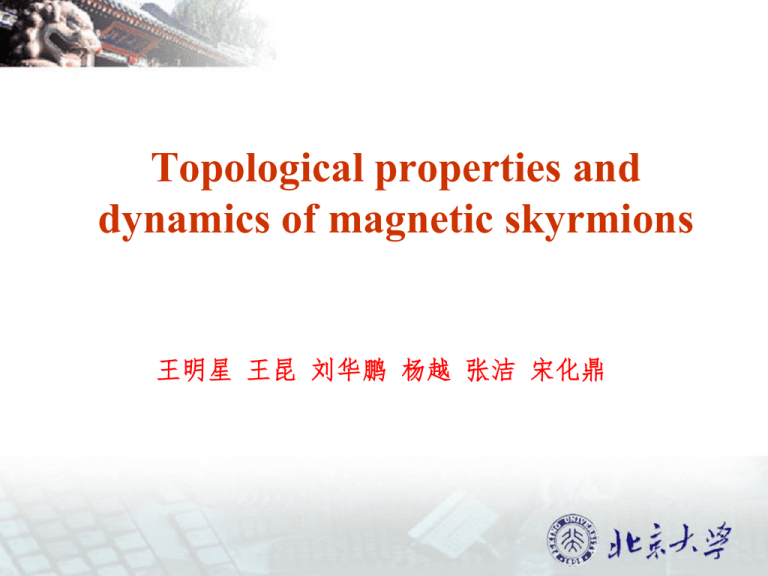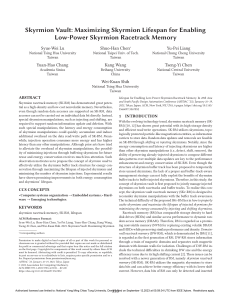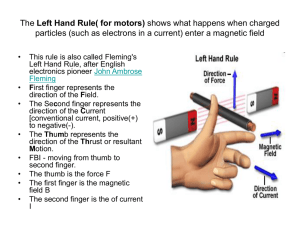Topological hall effect
advertisement

Topological properties and dynamics of magnetic skyrmions 王明星 王昆 刘华鹏 杨越 张洁 宋化鼎 Introduction The skyrmion is a hypothetical particle related originally to baryons. It was described by Tony Skyrme and consists of a quantum superposition of baryons and resonance states. Science, February 13, 2009, Vol 323, Issue 5916 • The existence of skyrmions at room temperature • The size is 6nm. • remain stable against collapse to the atomic scale • Lower drive Current. • high-responsivity Skyrmions can give a new approach to electronic memory mechanisms of skyrmions • Long-ranged magnetic dipolar interactions. • The relativistic Dzyaloshinskii–Moriya (DM) interaction • Frustrated exchange interactions • four-spin exchange interactions Skyrmion crystal (SkX) Consider a ferromagnet, introduce the DM interaction H DM D S ij i Sj ij DM interaction destroy centeral inversion symmetry of the entire spin system , because Skyrmion configuration also destroy the central inversion symmetry , so we have reason to believe that the presence of DM interaction can be extended Skyrmion phase external magnetic field B=0 Phys. Rev. Lett. 111, 186805 (2013) external magnetic field B≠0 In certain magnetic field and temperature Multi -state wave vector state will be appeared. For this state corresponds to a bigger entropy which can reduce the work function Effectively. Skyrmion crystals can treat as three wave vector with the same length and the respective angles of 120 °superimpose together k=0. Observation of skyrmions in chiral-lattice magnets Neutron scattering experiments on MnSi and Fe1–xCoxSi ‘A phase’ with a two-dimensional skyrmion crystal (SkX) phase. the SkX is stabilized by thermal fluctuations above the conical state in a limited region near the transition temperature, while the conical state with the wavevector Q parallel to the magnetic field is more stable in the rest of the phase diagram the magnetic scattering of neutrons (and possibly of X-rays) The reciprocal-space SANS patterns for the SkX on the plane normal to the incident neutron k-vector shows up as a hexagon with the norm of |Q|, that is, Fourier transform of the two-dimensional hexagonal SkX lattice. LTEM (001) thin plate of Fe0.5Co0.5Si with B20-type chiral crystal structure below the magnetic transition temperature (~40 K) zero magnetic field stripy pattern this corresponds to the proper screw spin structure propagating along [100] or [010]. A hexagonal lattice is formed by periodic arrays of spin-swirling structures. The helicity in each skyrmion reflects the sign of the DM interaction of this compound, hence indicating the uniformity of the chiral domain of the crystal structure. Phase diagrams of thin-film samples of chiral magnets as a function of magnetic field and temperature . The dependence of the SkX phase diagram for FeGe on the sample thickness (t). H, helical state; FM, ferromagnetic state. The colour scale indicates the skyrmion density per square micrometre. some examples of the helimagnetic phases In a thin (~50 nm) c-plane film of BFSO, in which the magnetic anisotropy is controlled and slightly weakened by Sc doping Ba (Fe 1 x 0.05 Sc x M g 0.05 )12 O19 centrosymmetric magnet a highly disordered helimagnetic texture with frequent reversals of magnetic helicity is observed at room temperature and in zero magnetic field a magnetic field Emerge SkX phase each skyrmion shows as either a black or a white circle-disk in a random manner indicate skyrmion helicity (for example, clockwise or anticlockwise curl of the in-plane M) is not correlated Increase field strength skyrmion size tends to decrease Topological phenomena related to skyrmions • “Topological hall effect” and “Skyrmion hall effect” • Both arising from emergent electromagnetic field of Skyrmion crystal • Difference Topological phenomena related to skyrmions • Take MnSi for example. • In the phase picture, in SkX region an anomalous Hall effect contribution could be detected. Leading to topological hall effect. PRL 102, 186602 (2009) • Up to now,topological hall effect has been broadly reported in MnSi 、 MnGe etc.But Skyrmion hall effect is much more difficult to detected even though theoritical work is already completed. • To describe motion of conduction electron in a Skyrmion crystal,one can have: • The Boltzmann equation.e and b are emergent electromagnetic field in Skyrmion crystal,f is the Fermi-Dirac distribution function. • Because of the term ,topological hall effect occurs due to b. • A modulation occurs in Phase A region • ~5nΩ • The signal contains three parts: • Normal hall effect, anomalous hall effect, topological hall effect. • Topological contribution is the anomalous modulation. PRL 102, 186602 (2009) • Skyrmion hall effect: motion of Skyrmion itself • Threshold Jc~~102Acm-2 • When current density>Jc, driving Skyrmion crystal to move • rotational symmetry in spin space is broken by the external magnetic field, and hence the spin wave modes are gapped, that is a phonon of the skyrmion crystal. • the three k = 0 skyrmion ‘optical’ modes:anticlockwise (ACW) rotation, clockwise (CW) rotation and breathing modes of the skyrmion core a universal current–velocity relation for the skyrmion crystal almost independent of αG, β and impurity pinning The reduced critical current density for the skyrmion crystal was attributed to the deformation of the crystal and of individual skyrmions to avoid the impurity potential In summary A skyrmion is a topologically stable particle observed in certain magnets, which has peculiar dynamics. Because skyrmions comprise many spins, thermal and quantum fluctuations are expected to be small, which is advantageous for memory Applications. From an applications perspective, the nanoscale fabrication of samples is an important step, along with the design and demonstration of skyrmion logic circuits enabled by fundamental understanding of the basic physics of the skyrmions.









